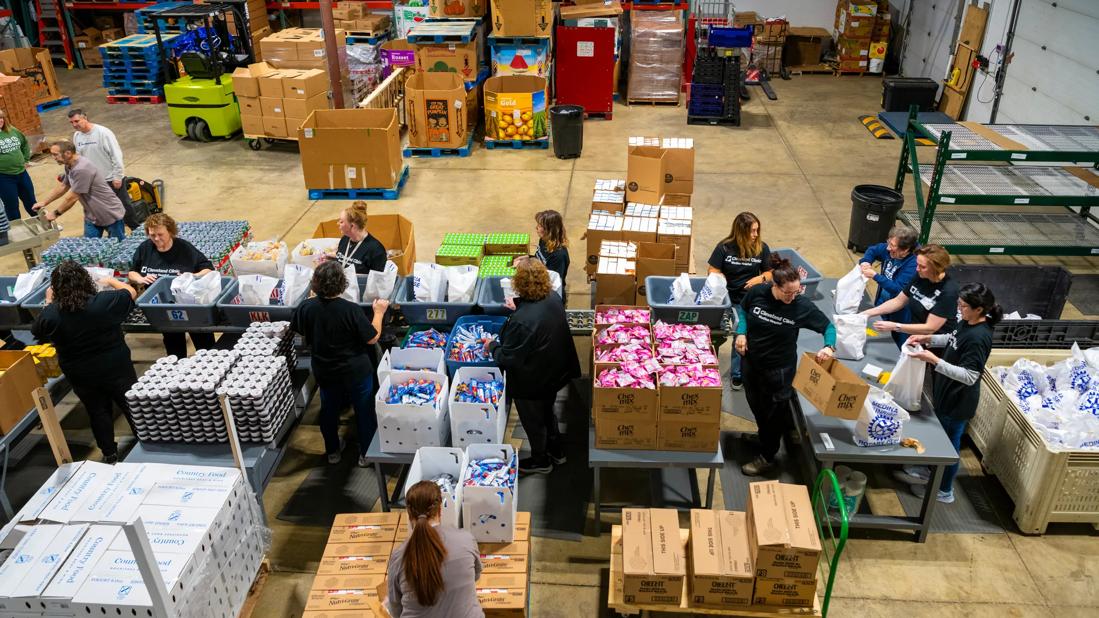Hoyle highlights cuts to SNAP, other social assistance during Eugene visit – NPR for Oregonians

Report on Social Assistance Reductions and Sustainable Development Goal Implications in Oregon
Introduction
Recent federal legislative changes, specifically the “One Big Beautiful Bill Act,” have resulted in significant cuts to social assistance programs. This report analyzes the consequential impacts on the state of Oregon, with a particular focus on the challenges posed to achieving several key United Nations Sustainable Development Goals (SDGs).
Impact on SDG 1 (No Poverty) and SDG 10 (Reduced Inequalities)
The enacted funding cuts directly threaten progress on SDG 1 (No Poverty) and SDG 10 (Reduced Inequalities) by weakening the social safety net for vulnerable populations in Oregon. The state exhibits a high dependency on these programs.
- Nearly 18% of Oregon’s population received Supplemental Nutrition Assistance Program (SNAP) benefits in the last year, the fourth-highest rate in the nation.
- Over 30% of state residents are enrolled in Medicaid, representing the seventh-highest rate in the U.S.
- U.S. Representative Val Hoyle expressed concern that these cuts will exacerbate hardship, stating, “a lot of people are going to be hurting.”
- The burden of support is shifting from the federal government to non-profit organizations and community charity, potentially deepening inequalities.
Impact on SDG 2 (Zero Hunger)
The reductions in federal support have created a critical challenge to ensuring SDG 2 (Zero Hunger). Food security in the region is under significant strain, as evidenced by the situation at Food for Lane County.
- Visits to Food for Lane County pantries have increased by 101% since 2022, with further increases anticipated.
- Food supplies are diminishing due to a combination of factors:
- A decrease in community food donations, often linked to high inflation.
- The cancellation of a key USDA program in April that supplied food banks with essential items from U.S. farmers.
- Rebecca Sprinson, the organization’s Development Director, highlighted the severity of the issue, noting numerous empty shelves at the facility.
Impact on SDG 3 (Good Health and Well-being)
The legislative changes pose a direct risk to SDG 3 (Good Health and Well-being). With over 30% of Oregonians reliant on Medicaid, cuts to the program jeopardize access to essential healthcare services for a substantial portion of the population. Furthermore, the rising food insecurity detailed under SDG 2 is intrinsically linked to negative health outcomes, compounding the public health challenge.
Impact on SDG 8 (Decent Work and Economic Growth)
The new legislation introduces measures that complicate the state’s progress toward SDG 8 (Decent Work and Economic Growth) through stricter benefit eligibility and a challenging economic outlook.
- New work requirements for social assistance have been implemented:
- The age for SNAP work requirements has been raised by a decade to 64 years old.
- Work requirements have been newly imposed on parents of most teenage children and on veterans.
- Oregon’s capacity to mitigate these impacts is limited by its own recent state budget cuts.
- Broader economic pressures, including rising unemployment and the potential for a drop in exports from reciprocal tariffs, threaten to further hinder the state’s economy and public finances.
1. Which SDGs are addressed or connected to the issues highlighted in the article?
The article discusses issues related to social assistance programs, food security, healthcare, and economic stability, which are directly connected to several Sustainable Development Goals (SDGs). The primary goals addressed are:
- SDG 1: No Poverty – The article focuses on cuts to social assistance programs like the Supplemental Nutrition Assistance Program (SNAP), which are designed to support low-income individuals and families, directly relating to poverty alleviation.
- SDG 2: Zero Hunger – The central theme is the impact of SNAP cuts on food security. The increased demand on food banks, the cancellation of a federal food supply program, and rising food insecurity among Oregonians are core to this goal.
- SDG 3: Good Health and Well-being – The mention of Medicaid, a key public health insurance program, and the high percentage of Oregonians enrolled, connects the article to the goal of ensuring healthy lives and promoting well-being.
- SDG 8: Decent Work and Economic Growth – The article touches upon economic challenges, including “rising unemployment” and changes to work requirements for SNAP eligibility, which are relevant to this goal.
- SDG 17: Partnerships for the Goals – The discussion about the federal government’s role versus that of non-profits like Food for Lane County highlights the dynamic between public and civil society sectors, which is central to SDG 17.
2. What specific targets under those SDGs can be identified based on the article’s content?
Based on the issues discussed, several specific SDG targets can be identified:
SDG 1: No Poverty
- Target 1.3: Implement nationally appropriate social protection systems and measures for all, including floors, and by 2030 achieve substantial coverage of the poor and the vulnerable. The article directly discusses SNAP and Medicaid, which are key social protection systems in the U.S. The concern over cuts to these programs indicates a threat to this target.
SDG 2: Zero Hunger
- Target 2.1: By 2030, end hunger and ensure access by all people, in particular the poor and people in vulnerable situations… to safe, nutritious and sufficient food all year round. The article highlights a crisis in food access, evidenced by the 101% increase in visits to food pantries and the statement that “a lot of people are going to be hurting” due to cuts in food assistance.
SDG 3: Good Health and Well-being
- Target 3.8: Achieve universal health coverage, including financial risk protection, access to quality essential health-care services… The article notes that “More than 30% of state residents are on Medicaid,” a program providing essential health coverage. Potential cuts to such programs would directly impact the achievement of this target.
SDG 8: Decent Work and Economic Growth
- Target 8.5: By 2030, achieve full and productive employment and decent work for all… The article mentions “rising unemployment” as a factor that will “hinder the economy.” It also discusses new “work requirements for parents of most teenage children and veterans” to receive SNAP benefits, linking social assistance directly to employment status.
SDG 17: Partnerships for the Goals
- Target 17.17: Encourage and promote effective public, public-private and civil society partnerships… The statement, “I don’t think that nonprofits should be the ones that do the job of the federal government, but this is where we are,” explicitly addresses the shifting burden from the public sector (federal government) to the civil society sector (non-profits like Food for Lane County), indicating a strain on this partnership.
3. Are there any indicators mentioned or implied in the article that can be used to measure progress towards the identified targets?
The article provides several specific data points and qualitative statements that can serve as indicators for measuring progress.
Indicators for SDG 1 & SDG 3
- For Target 1.3 (Social Protection) and Target 3.8 (Health Coverage): The article provides direct quantitative indicators of social protection system coverage.
- “Nearly 18% of Oregonians received SNAP benefits last year.” This serves as an indicator for the proportion of the population covered by food assistance programs.
- “More than 30% of state residents are on Medicaid.” This is a direct indicator of the population covered by a key public health program.
Indicators for SDG 2
- For Target 2.1 (End Hunger): The article implies a rise in food insecurity through several proxy indicators.
- “Visits to Food for Lane County pantries has risen 101% since 2022.” This is a strong indicator of increased need and food insecurity.
- The mention of “empty shelves” at the food bank and the fact that “food donations are down” are qualitative indicators of a strained food supply system for the vulnerable.
- The cancellation of the “program within the USDA that purchased essential food from US farmers and provided it to food banks” is an indicator of reduced government support for food security infrastructure.
Indicators for SDG 8
- For Target 8.5 (Full Employment): The article points to a negative trend in employment.
- The mention of “rising unemployment” is a direct reference to the unemployment rate, a key economic indicator for this target.
4. Table of SDGs, Targets, and Indicators
| SDGs | Targets | Indicators Identified in the Article |
|---|---|---|
| SDG 1: No Poverty | 1.3: Implement nationally appropriate social protection systems. | Proportion of population receiving SNAP benefits (stated as “Nearly 18% of Oregonians”). |
| SDG 2: Zero Hunger | 2.1: End hunger and ensure access to food for all. | Percentage increase in visits to food pantries (“risen 101% since 2022”); Status of food bank supplies (“empty shelves”); Cancellation of federal food provision programs (USDA program). |
| SDG 3: Good Health and Well-being | 3.8: Achieve universal health coverage. | Proportion of population covered by public health insurance (“More than 30% of state residents are on Medicaid”). |
| SDG 8: Decent Work and Economic Growth | 8.5: Achieve full and productive employment. | Trend in unemployment rate (“rising unemployment”); Changes in work requirements for social assistance eligibility. |
| SDG 17: Partnerships for the Goals | 17.17: Encourage effective public, public-private and civil society partnerships. | Shifting of responsibility from federal government to non-profits; Cuts in federal funding and programs supporting civil society partners. |
Source: klcc.org

What is Your Reaction?
 Like
0
Like
0
 Dislike
0
Dislike
0
 Love
0
Love
0
 Funny
0
Funny
0
 Angry
0
Angry
0
 Sad
0
Sad
0
 Wow
0
Wow
0


-1920w.png?#)





































































